Calf raises are a lower body exercise that targets the calf muscles, specifically the gastrocnemius and soleus muscles.
Calf raises have straightforward mechanics. You raise your heels off the floor or a slightly elevated surface, standing on the balls of your feet. Then, lower your heels back down to the starting position in a controlled manner.
It helps increase the size and tone of calves, resulting in stronger calves. It also helps stabilize your ankles and improve your walking motion.
There are many variations of calf raises that can be used at home or the gym, depending on equipment availability, choice, and fitness level. Here are some popular options:
- Standing Calf Raise: This can be done on a step or any elevated surface to increase the range of motion. Mainly train gastrocnemius muscles.
- Seated Calf Raise: This variation targets the soleus muscle more effectively.
- Bodyweight Calf Raises: Effective way to build calf muscle at home.
- Single-Leg Calf Raise: One leg at a time, increases the intensity, promoting balance and stability.
- Donkey Calf Raise: It provides a unique stretch and contraction for the calves.
- Smith Machine Calf Raise: this allows you to add more weight and focus on the contraction safely.
- Resistance Band Calf Raise: Great for home workouts
However, like any other exercise, calf raises require proper form, technique, and consistency to see results. That’s where this ultimate guide to calf raises is helpful.
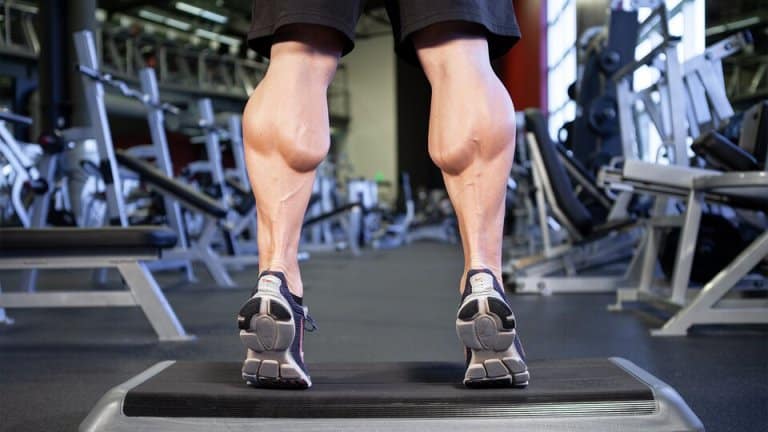
- Calf Muscle Anatomy
- Calf Raise Muscles Worked
- How To Do Bodyweight Calf Raise
- Tips and Techniques
- Foot Position for Calf Raises
- 5 Best Calf Raise Variations
- 1. Seated Machine Calf Raise
- 2. Donkey Calf Raise
- 3. One Leg Calf Raise
- 4. Smith Machine Calf Raise
- 5. Barbell Seated Calf Raise
- FAQs
- Common Issues Related to Weak Calf Muscles
- Do calf raise to make you jump higher?
- How many calf raises should I do
- Can calf raises make you faster
- Do calf raises work on hamstrings and glutes?
Calf Muscle Anatomy
Before we dive into the different types of calf raises, it’s important to have a basic understanding of the anatomy of the calf muscles.
The calf muscles comprise two main muscles: the gastrocnemius and the soleus.
- Gastrocnemius: It is the larger, more visible muscle of the calf. It forms the bulge in the upper part of the lower leg and is responsible for the diamond-shaped appearance. This muscle originates above the knee joint and consists of two heads: the medial and the lateral.
- Soleus: Located underneath the gastrocnemius and is responsible for stabilizing the ankle joint. While it doesn’t directly contribute to the visible shape of the calf, it is equally important for lower leg function.
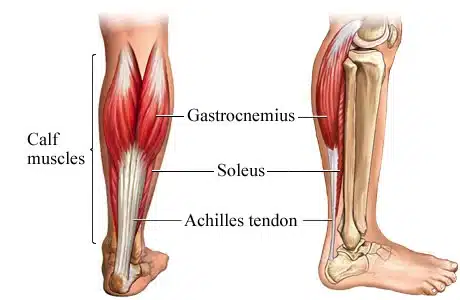
Want to take your gains to the next level? Discover your daily calorie needs with our free TDEE calculator
Calf Raise Muscles Worked
Several muscles are worked primarily in the lower leg when performing calf raises.
- The calves (Gastrocnemius, Soleus) are the main muscles worked during calf raises.
- The secondary and stabilizing muscles that work during this process are the tibialis anterior and posterior and flexor hallucis longus (responsible for flexing that toe).
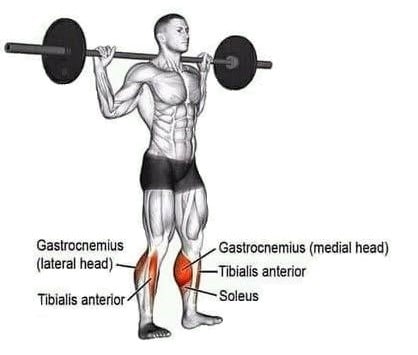
How To Do Bodyweight Calf Raise
The standing bodyweight calf raise is a really easy exercise to do. They only use body weight, so they’re a convenient calf exercise you can do at home or anywhere.
- Beginners Variations: Supported Calf Raise, Floor Calf Raise
- Advanced Variations: Single-leg calf Raise
- Stand with your feet hip-width apart on an elevated surface or stair.
- Keep your feet hip-width apart and your toes pointing forward.
- If needed, you can place your hands on your hips or hold onto a wall or sturdy object for balance.
- Raise your heels by pressing the balls of your feet into the ground.
- You should raise your body until you are on your toes.
- Hold this position and then slowly lower your heels back to the ground.
- Repeat for the desired number of reps (typically 10-20 per set).
Tips and Techniques
Calf raises may appear to be a simple exercise, but like any exercise, there are common mistakes that people often make.
Knowing and avoiding these mistakes will help you get the most out of your calf raises and reduce the risk of getting hurt.
- The most common mistake is to use excessive weight. If you use too much weight, you can hurt yourself by putting too much pressure on your joints. Choose a weight that allows you to keep your form.
- Some people raise their heels only partially, which means an incomplete full range of motion. Try to raise your heels as high as possible and focus on the contraction of the calf muscles at the top of the move.
- Avoid jerky motions, as they can reduce the workout’s effectiveness. Make sure to use slow, controlled movements throughout the entire exercise.
- Keep your feet shoulder-width apart, with your toes pointing forward. Placing your feet too far apart or too close together can shift the emphasis away from the calves and onto other muscle groups.
- Many people tend to rush through the eccentric phase or ignore it entirely. The eccentric phase of the calf raise, where you lower your heels back down, is equally important as the concentric phase (raising the heels).
- As you get stronger, incorporate dumbbells, a barbell, or a weighted vest to increase resistance.
- Try different variations of calf raises, such as single-leg calf raises, or seated calf raises.
- After your workout, take the time to stretch your calf muscles to improve flexibility and reduce muscle soreness.
- Select the set, reps, and frequency for the calf raises, per your fitness level.
| Level | Sets | Reps | Frequency |
|---|---|---|---|
| Beginner | 2-3 | 10-12 | 1-2 times per week |
| Intermediate | 3-4 | 12-15 | 2-3 times per week |
| Advanced | 4-5 | 12-15 | 2-3 times per week |
Foot Position for Calf Raises
To do calf raises, stand with your feet hip-width apart. For a standard calf raise, position your toes pointing forward, parallel to one another.
In this study, the researchers compare how different foot positions affect different areas of the calf muscles:
- To emphasize the medial (inner) calf muscles, turn your toes slightly outward (outward toe angle).
- To target the lateral (outer) calf muscles, turn your toes slightly inward (inward toe angle).
- For a more balanced approach, keep your toes pointing straight ahead.
5 Best Calf Raise Variations
There are different variations of calf raises that you can do to target different areas of your calf muscles. Here are some of the most common types of calf raises:
1. Seated Machine Calf Raise
A seated calf raises primarily targets the calf muscles (soleus and gastrocnemius). It is performed while seated, with the feet on a platform and the weight on the thighs.
The movement involves lifting the weight by extending the ankle, and lowering it by flexing it.
There are many ways you can do a seated calf raise with a dumbbell, barbell, and machine.
The following muscles were engaged during the seated calf raise workout.
- The main target muscle is the soleus,
- While the gastrocnemius acts as a synergist or assisting muscle.
Since the soleus comprises slow-twitch muscle fibers, performing the seated calf raise builds the endurance required for running, cycling, and walking.

How To Do
- Sit in the seated calf machine and place your feet on the foot plate so that your heels hang off the edge.
- Place the knee pad on your knees and unrack the weight.
- Drop your heels as low as possible to get a good stretch in your calves.
- Lift your heels by contracting the calf muscles to raise the weight as high as you can on the balls of your feet.
- Hold this position for a second, flexing your calf muscles, then lower your heels back to the starting position.
2. Donkey Calf Raise
Donkey calf raises are an excellent bodyweight calf raise exercise for building calf muscles. This raise is mostly the second option after standing calf raises.
The donkey calf raises primarily engages the two muscles that comprise the calves: the gastrocnemius and the soleus.
The donkey calf raises secondarily activates the hamstrings and abs. When you bend over to initiate the calf raise, the hamstrings receive a stretch.
Note: Do advanced modifications to make the donkey calf raise exercise more challenging.
- Single-Leg Donkey Calf Raises
- Partner/Weighted Donkey Calf Raise
- Donkey Calf Raises on Machine
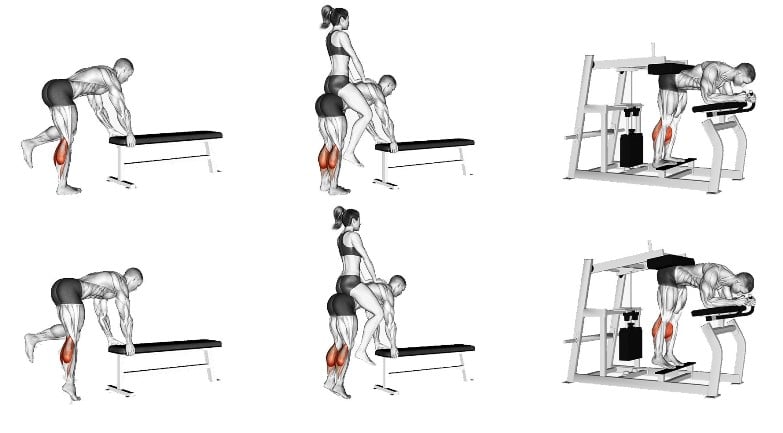
How To Do
- For this exercise, you will need access to a donkey calf-raise machine. If you do not have a machine, try bodyweight variation.
- Stand on a board and hold a table for support.
- Place the balls of your feet on the calf block with the heels extending off.
- Align the toes forward, inward or out, depending on the area you want to target, and straighten the knees without locking them.
- As you exhale, elevate your heels by extending your ankles as far as possible and flexing your calf.
- As you breathe in, slowly return to the starting position, lowering your heels and bending your ankles until the calves are stretched.
- Extend your calves and get back to the starting position.
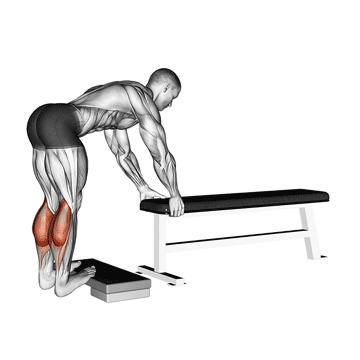
Read More: Bodyweight Calf Raise To Build Mass And Strength Of Calves
3. One Leg Calf Raise
Single-leg calf raises are another great exercise for your calf raises workout. It’s a must-have on the list of the top-notch calf workouts.
It doesn’t require any equipment, but you can add dumbbells to make it harder. It doesn’t take up much space and anyone can do it.
If you don’t have a platform to perform the standing dumbbell one-leg calf raises, you can do it on the floor.
- Beginners Variations: Single legs standing calf raise.
- Advanced Variations: Single-leg raise with a dumbbell, isometric holds, calf raises on an unstable surface
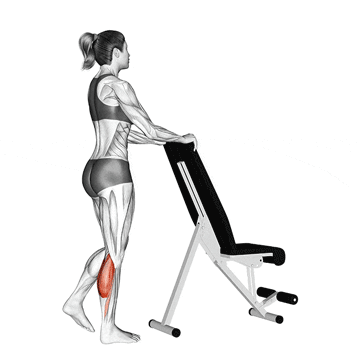
How To Do
- With your left foot, stand on a platform, with the arch and heel of your foot suspending off.
- Grasp something with your right hand for stability.
- Exhale as you raise your heel by extending your ankle.
- Hold for a count. Inhale as you slowly reverse the motion and lower your heel until you feel a mild stretch in your calf.
- Hold for a count of one. Repeat for more repetitions. Repeat with your right leg.
4. Smith Machine Calf Raise
The fixed bar of the Smith machine allows you to isolate your calves better by minimizing body movement. It is a helpful exercise for beginners or those recovering from injuries.
The machine’s safety features, such as adjustable safety stops, let you lift heavier weights confidently.
The Smith machine allows for various foot positions and angles, enabling you to target different parts of your calf muscles.
There are many variations of the Smith machine calf raise you can try.
- Standing Smith Machine Calf Raise
- Seated Smith Machine Calf Raise
- Single-Leg Calf Raise
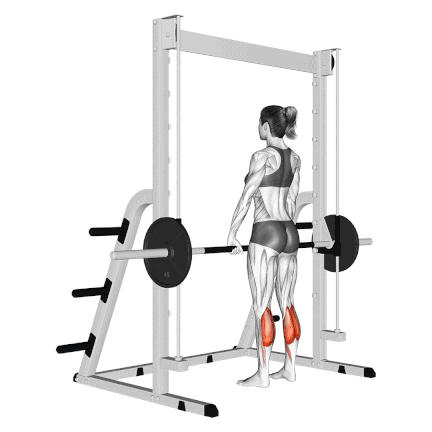
How To Do
- Load the bar and step onto the plates with the balls of your feet
- Place the bar on the back of your shoulders.
- Hold the bar with both hands facing forward.
- Rotate the bar so that it is unracked from the smith machine.
- Push off the balls of your feet to raise your heels as high as possible.
- Flex your calf at the top of the contraction. Hold the contracted position for a second.
- Breathe in as you return to the starting position by lowering your heels.
5. Barbell Seated Calf Raise
The barbell seated calf raise is a great variation of the seated calf raise if you have limited equipment (e.g., a home setup). However, you can still utilize it as a gym exercise.
The seated position allows you to lift heavier weights compared to standing variations because your upper body is supported. This can lead to faster muscle growth and increased strength.
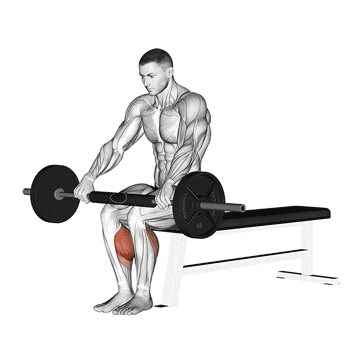
How To Do
- Sit on the end of a bench or chair and place the barbell on the end of your thighs near your knee but not on your knee.
- Sit up straight and place the top half of your feet or the balls of your feet on the floor or elevated object so that your heels hang off.
- Have a firm grip on the barbell to keep it in one place.
- Lift your heels by contracting the calf muscles to raise the weight as high as you can on the balls of your feet.
- Hold this position for a second, flexing your calf muscles, then lower your heels back to the starting position.
FAQs
Common Issues Related to Weak Calf Muscles
Weak calf muscles can lead to various issues and imbalances, including:
- Decreased Athletic Performance: A weak calf hinders performance in sports that require explosive movements, agility, and quick direction changes.
- Increased Injury Risk: Weak calf muscles can contribute to a higher risk of injuries, such as calf strains, Achilles tendonitis, and shin splints.
- Imbalanced Lower Body: Neglecting calf strength can create muscle imbalances, potentially leading to issues in the knees, hips, and ankles.
Do calf raise to make you jump higher?
Studies have shown that calf exercises, like calf raises and jumping calf raises, help improve vertical jump height. The calf muscles, specifically the gastrocnemius and soleus, are essential for generating force during jumping movements.
Strengthening these muscles through exercises like calf raises can enhance their ability to produce power and contribute to increased jump performance.
How many calf raises should I do
- Begin with 2–3 sets of 10–15 reps for the calf raise.
- Gradually increase the sets and reps as you get stronger and more comfortable.
- For more advanced training, try to do 3–4 sets of 12–20 reps or 4–5 sets of 15–25 reps.
Can calf raises make you faster
Yes, calf raises contribute to improving your speed. A study has shown that strengthening the calf muscles can strengthen your lower legs.
This can make you faster and more powerful when you do activities like running and sprinting.
Do calf raises work on hamstrings and glutes?
Calf raises primarily target the calf muscles, specifically the gastrocnemius and soleus. While they also activate the hamstrings and glutes as stabilizing muscles, they are not the primary focus of the exercise.

Manish is a NASM-certified fitness and nutrition coach with over 10 years of experience in weight lifting and fat loss fitness coaching. He specializes in gym-based training and has a lot of knowledge about exercise, lifting technique, biomechanics, and more.
Through “Fit Life Regime,” he generously shares the insights he’s gained over a decade in the field. His goal is to equip others with the knowledge to start their own fitness journey.
